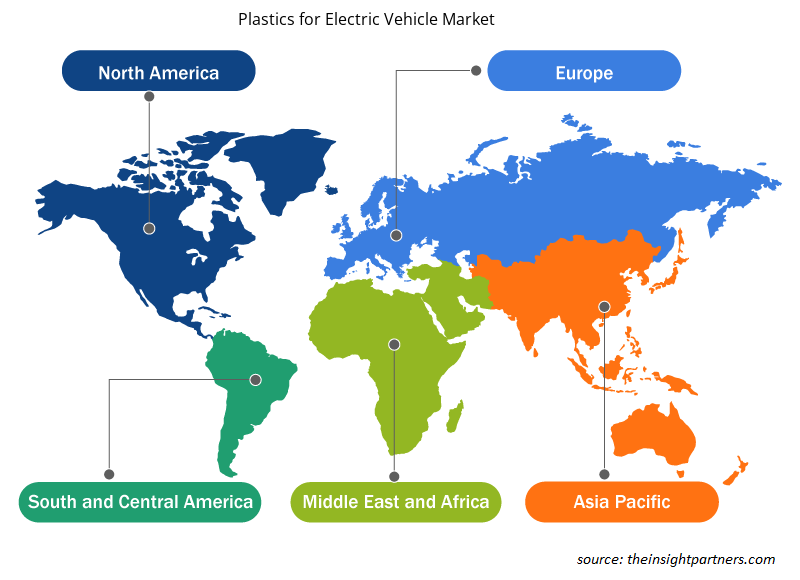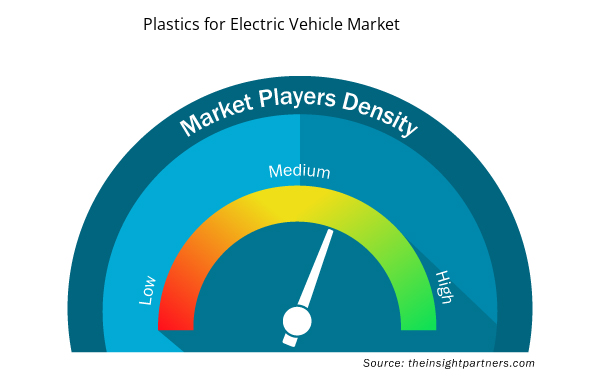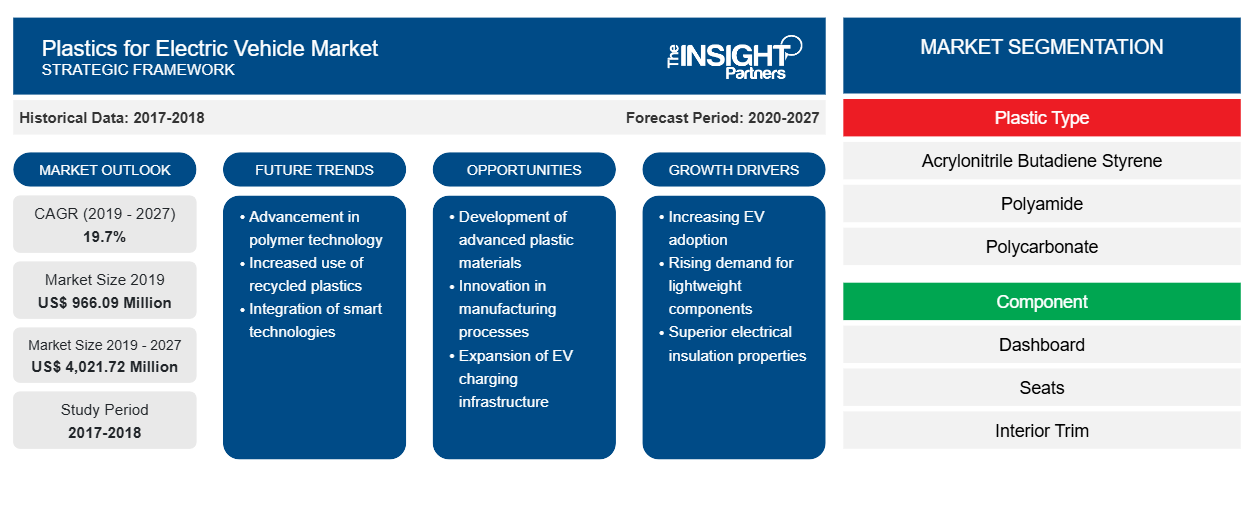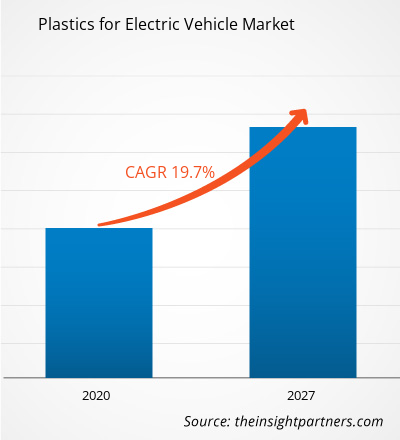2019 年电动汽车塑料市场价值为 9.6609 亿美元,预计到 2027 年将达到 40.2172 亿美元;预计 2020 年至 2027 年的复合年增长率为 19.7%。
塑料既可以作为电导体,也可以作为绝缘体。由于塑料用途广泛且易于成型,因此可以根据电动汽车的要求生产各种形状和设计。电动汽车使用塑料可以减轻汽车重量,从而增加充电间隔。塑料具有出色的耐热性,可用于构建电池舱和冷却系统,并且不会影响电动汽车的耐用性和安全性。预计 2020-2027 年期间,北美电动汽车用塑料市场将以 20.0% 的最高复合年增长率增长。
2019 年 12 月,武汉首次报告了 COVID-19 疫情。截至 2020 年 6 月,美国、俄罗斯、印度、西班牙、巴西、意大利、法国和德国是 COVID-19 确诊病例和死亡人数最多的国家。由于封锁、旅行禁令和企业停业,疫情对经济和行业产生了不利影响。化学品和材料是世界主要行业之一,受到供应链中断、技术活动取消和办公室关闭等严重影响。中国是全球制造业中心,也是全球各行业最大的原材料供应国,也是受 COVID-19 疫情影响最严重的国家之一。中国各工厂的封锁限制了全球供应链以及各种化学品和材料产品的制造和销售。因此,疫情的整体影响抑制了电动汽车用塑料市场的增长。
定制此报告以满足您的需求
您可以免费定制任何报告,包括本报告的部分内容、国家级分析、Excel 数据包,以及为初创企业和大学提供优惠和折扣
- 获取此报告的关键市场趋势。这个免费样品将包括数据分析,从市场趋势到估计和预测。
市场洞察
电动汽车需求增长推动市场增长
随着人们越来越重视环境可持续性,汽车制造业正朝着减少温室气体排放和提高燃油效率的方向发展。成本效益、环境可持续性、便利性、采用先进技术以及各种政府政策(如优惠费率、设备购买激励措施和大幅回扣)是推动全球电动汽车需求的因素之一。根据国际能源署的数据,2019 年全球电动汽车销量同比增长 40%,达到 210 万辆,大大超过 2018 年。
塑料类型洞察
根据塑料类型,电动汽车用塑料市场细分为丙烯腈丁二烯苯乙烯 (ABS)、聚酰胺 (PA)、聚碳酸酯 (PC)、聚乙烯醇缩丁醛、聚氨酯 (PU)、聚丙烯 (PP) 等。聚丙烯 (PP) 部分在 2019 年占据了最大的市场份额。聚丙烯 (PP) 是指由丙烯单体组合而成的热塑性“加成聚合物”。它坚硬且结晶;因此,它被广泛用于制造包装托盘、医疗设备等物品。作为聚烯烃树脂的重要家族之一,它可以模塑和挤压成任何需要柔韧性、韧性、重量轻和耐热性的塑料类型。
组件洞察
根据组件,电动汽车塑料市场细分为仪表板、座椅、内饰、汽车内饰、保险杠等。内饰部分在 2019 年占据了最大的市场份额。电动汽车的内饰是指车厢内的塑料部件或面板。具有令人愉悦的功能和美观装饰对于提供完美的内部体验至关重要。
车辆类型洞察
根据车辆类型,电动汽车塑料市场分为 BEV 和 PHEV/HEV。BEV 细分市场在 2019 年占据了最大的市场份额。纯电动汽车或 BEV 使用高容量电池组在车上储存电力。电池中的电力用于运行电动机和车上的其他电子设备。塑料用于制造电动汽车所需电气元件的连接器和外壳。
应用程序洞察
根据应用,电动汽车用塑料市场进一步细分为动力系统/引擎盖下、外部、内部以及照明和电线。内饰部分在 2019 年占据了最大的市场份额。高性能塑料用于电动汽车,提供安全性和保障。聚丙烯经常用于汽车零部件,例如汽油罐和内饰地板的地毯纤维。PVC 因其光滑的表面而用于汽车油箱和仪表板。方向盘和仪表板也采用丙烯腈丁二烯苯乙烯或 ABS 塑料生产。塑料在方向盘、内饰地板和控制台中的广泛应用有利于电动汽车用塑料内饰市场的增长。
电动汽车用塑料市场区域洞察
Insight Partners 的分析师已详细解释了预测期内影响电动汽车塑料市场的区域趋势和因素。本节还讨论了北美、欧洲、亚太地区、中东和非洲以及南美和中美洲的电动汽车塑料市场细分和地理位置。

- 获取电动汽车市场塑料的区域特定数据
电动汽车用塑料市场报告范围
| 报告属性 | 细节 |
|---|---|
| 2019 年市场规模 | 9.6609亿美元 |
| 2027 年市场规模 | 40.2172亿美元 |
| 全球复合年增长率(2019 - 2027) | 19.7% |
| 史料 | 2017-2018 |
| 预测期 | 2020-2027 |
| 涵盖的领域 | 按塑料类型
|
| 覆盖地区和国家 | 北美
|
| 市场领导者和主要公司简介 |
|
电动汽车市场参与者的塑料密度:了解其对业务动态的影响
电动汽车塑料市场正在快速增长,这得益于终端用户需求的不断增长,而这些需求又源于消费者偏好的不断变化、技术进步以及对产品优势的认识不断提高等因素。随着需求的增加,企业正在扩大其产品范围,进行创新以满足消费者的需求,并利用新兴趋势,从而进一步推动市场增长。
市场参与者密度是指在特定市场或行业内运营的企业或公司的分布情况。它表明在给定市场空间中,相对于其规模或总市场价值,有多少竞争对手(市场参与者)存在。
在电动汽车塑料市场运营的主要公司有:
- 巴斯夫
- 索尔维公司
- 杜邦公司
- 陶氏化学公司
- LG化学有限公司
免责声明:上面列出的公司没有按照任何特定顺序排列。

- 了解电动汽车塑料市场的主要参与者概况
报告亮点
- 全球电动汽车塑料市场的进步行业趋势有助于参与者制定有效的长期战略
- 发达市场和发展中市场采用的业务增长战略
- 2017年至2027年电动汽车用塑料市场定量分析
- 全球各行业电动汽车塑料需求估算
- PEST 分析说明市场中买家和供应商的运作效率
- 了解竞争激烈的市场形势和电动汽车对塑料的需求的最新发展
- 市场趋势和前景,以及推动和抑制市场增长的因素
- 了解支撑全球电动汽车塑料市场增长的战略,帮助利益相关者做出决策
- 电动汽车用塑料市场各市场节点规模
- 市场详细概述和细分以及行业动态
- 全球电动汽车用塑料市场各地区规模及各地区增长机遇
电动汽车市场用塑料,按塑料类型划分
- 丙烯腈丁二烯苯乙烯
- 聚酰胺
- 聚碳酸酯
- 聚乙烯醇缩丁醛
- 聚氨酯
- 聚丙烯
- 其他的
电动汽车市场塑料(按组件划分)
- 仪表板
- 座位
- 内饰
- 汽车内饰
- 保险杠
- 其他的
电动汽车市场塑料,按车型分类
- 纯电动汽车
- 插电式混合动力汽车/混合动力汽车
电动汽车市场塑料的应用
- 动力传动系统/ 引擎盖下
- 外部的
- 内部的
- 照明和电线
公司简介
- 巴斯夫
- 索尔维公司
- 杜邦公司
- 陶氏化学公司
- LG化学有限公司
- 朗盛公司
- 沙特基础工业公司
- 科思创公司
- 旭化成公司
- 利安德巴塞尔工业控股有限公司
- 历史分析(2 年)、基准年、预测(7 年)及复合年增长率
- PEST 和 SWOT 分析
- 市场规模价值/数量 - 全球、区域、国家
- 行业和竞争格局
- Excel 数据集



Report Coverage
Revenue forecast, Company Analysis, Industry landscape, Growth factors, and Trends

Segment Covered
This text is related
to segments covered.

Regional Scope
North America, Europe, Asia Pacific, Middle East & Africa, South & Central America

Country Scope
This text is related
to country scope.
常见问题
In 2019, Asia Pacific held the largest share of the global plastics for electric vehicles market. The demand for plastics for electric vehicles is expected to increase in the region with the increase in the educated population who demand for more and more electric vehicles. The rise in disposable income and per capita consumption supports the market growth. The rising production capacities of the manufacturers of plastics favors the growth of plastics for electric vehicles market in the region. Continuous innovations in the application of plastics for electric vehicles is yet another factor driving the demand for plastics for electric vehicles. Besides these, rising awareness about the benefits of electric vehicles and initiatives taken by the Government for supporting the demand for plastics for electric vehicles, provides lucrative opportunity for the development of plastics for electric vehicles market in Asia Pacific.
The growth of polyurethane segment is primarily attributed to the fact that polyurethane (PU) is considered to be one of the most versatile plastic materials. It is formed by the reaction of polyol along with a di- isocyanate or a polymeric isocyanate in the presence of an additive or a catalyst. Polyurethane structure comprises of three complex monomers namely, diisocyanate, a macrodial and chain extender, on the basis of which many polyurethane materials can be synthesized. The polyurethane polymers are also characterized by the presence of urethane linkage. Depending on the length and nature of the hydroxyl and isocyanate molecule, the thermoplastic, hard, soft, flexible and cellular type of polyurethane is synthesized. The resultant structure resembles that of polyamide as both of them comprises of CONH groups. Polyurethane possess versatile properties like toughness, biocompatibility and durability that can be tailored depending on the application. In electronic vehicles, the engineers prefer using thermoset polyurethane adhesives for the purpose of bonding the dissimilar materials to the frame of cars. These adhesives are strong and helps in reducing the need for heavy and bulky bolts & rivets. They also help in keeping down the weight of the vehicle curb thus making the cars light & fast along with excellent charge range. Polyurethane is also used in shock absorption components in vehicles. The automakers also prefer using cast polyurethane in muffler systems. It is extensively used in electric vehicle car batteries and provide smoothest driving experience. All these factors are responsible for polyurethane segment to grow at the high rate.
The major players operating in the global plastics for electrical vehicle market are BASF SE, Solvay S.A., DuPont de Nemours, Inc., The Dow Chemical Company, LG Chem Ltd, Lanxess AG, Sabic, Covestro AG, Asahi Kasei Corporation and LyondellBasell Industries Holdings B.V.
Trends and growth analysis reports related to Chemicals and Materials : READ MORE..
The List of Companies - Global Plastics for Electric Vehicle Market
- BASF SE
- Solvay S.A.
- DuPont de Nemours, Inc.
- The Dow Chemical Company
- LG Chem Ltd
- Lanxess AG
- Sabic
- Covestro AG
- Asahi Kasei Corporation
- LyondellBasell Industries Holdings B.V
The Insight Partners performs research in 4 major stages: Data Collection & Secondary Research, Primary Research, Data Analysis and Data Triangulation & Final Review.
- Data Collection and Secondary Research:
As a market research and consulting firm operating from a decade, we have published and advised several client across the globe. First step for any study will start with an assessment of currently available data and insights from existing reports. Further, historical and current market information is collected from Investor Presentations, Annual Reports, SEC Filings, etc., and other information related to company’s performance and market positioning are gathered from Paid Databases (Factiva, Hoovers, and Reuters) and various other publications available in public domain.
Several associations trade associates, technical forums, institutes, societies and organization are accessed to gain technical as well as market related insights through their publications such as research papers, blogs and press releases related to the studies are referred to get cues about the market. Further, white papers, journals, magazines, and other news articles published in last 3 years are scrutinized and analyzed to understand the current market trends.
- Primary Research:
The primarily interview analysis comprise of data obtained from industry participants interview and answers to survey questions gathered by in-house primary team.
For primary research, interviews are conducted with industry experts/CEOs/Marketing Managers/VPs/Subject Matter Experts from both demand and supply side to get a 360-degree view of the market. The primary team conducts several interviews based on the complexity of the markets to understand the various market trends and dynamics which makes research more credible and precise.
A typical research interview fulfils the following functions:
- Provides first-hand information on the market size, market trends, growth trends, competitive landscape, and outlook
- Validates and strengthens in-house secondary research findings
- Develops the analysis team’s expertise and market understanding
Primary research involves email interactions and telephone interviews for each market, category, segment, and sub-segment across geographies. The participants who typically take part in such a process include, but are not limited to:
- Industry participants: VPs, business development managers, market intelligence managers and national sales managers
- Outside experts: Valuation experts, research analysts and key opinion leaders specializing in the electronics and semiconductor industry.
Below is the breakup of our primary respondents by company, designation, and region:

Once we receive the confirmation from primary research sources or primary respondents, we finalize the base year market estimation and forecast the data as per the macroeconomic and microeconomic factors assessed during data collection.
- Data Analysis:
Once data is validated through both secondary as well as primary respondents, we finalize the market estimations by hypothesis formulation and factor analysis at regional and country level.
- Macro-Economic Factor Analysis:
We analyse macroeconomic indicators such the gross domestic product (GDP), increase in the demand for goods and services across industries, technological advancement, regional economic growth, governmental policies, the influence of COVID-19, PEST analysis, and other aspects. This analysis aids in setting benchmarks for various nations/regions and approximating market splits. Additionally, the general trend of the aforementioned components aid in determining the market's development possibilities.
- Country Level Data:
Various factors that are especially aligned to the country are taken into account to determine the market size for a certain area and country, including the presence of vendors, such as headquarters and offices, the country's GDP, demand patterns, and industry growth. To comprehend the market dynamics for the nation, a number of growth variables, inhibitors, application areas, and current market trends are researched. The aforementioned elements aid in determining the country's overall market's growth potential.
- Company Profile:
The “Table of Contents” is formulated by listing and analyzing more than 25 - 30 companies operating in the market ecosystem across geographies. However, we profile only 10 companies as a standard practice in our syndicate reports. These 10 companies comprise leading, emerging, and regional players. Nonetheless, our analysis is not restricted to the 10 listed companies, we also analyze other companies present in the market to develop a holistic view and understand the prevailing trends. The “Company Profiles” section in the report covers key facts, business description, products & services, financial information, SWOT analysis, and key developments. The financial information presented is extracted from the annual reports and official documents of the publicly listed companies. Upon collecting the information for the sections of respective companies, we verify them via various primary sources and then compile the data in respective company profiles. The company level information helps us in deriving the base number as well as in forecasting the market size.
- Developing Base Number:
Aggregation of sales statistics (2020-2022) and macro-economic factor, and other secondary and primary research insights are utilized to arrive at base number and related market shares for 2022. The data gaps are identified in this step and relevant market data is analyzed, collected from paid primary interviews or databases. On finalizing the base year market size, forecasts are developed on the basis of macro-economic, industry and market growth factors and company level analysis.
- Data Triangulation and Final Review:
The market findings and base year market size calculations are validated from supply as well as demand side. Demand side validations are based on macro-economic factor analysis and benchmarks for respective regions and countries. In case of supply side validations, revenues of major companies are estimated (in case not available) based on industry benchmark, approximate number of employees, product portfolio, and primary interviews revenues are gathered. Further revenue from target product/service segment is assessed to avoid overshooting of market statistics. In case of heavy deviations between supply and demand side values, all thes steps are repeated to achieve synchronization.
We follow an iterative model, wherein we share our research findings with Subject Matter Experts (SME’s) and Key Opinion Leaders (KOLs) until consensus view of the market is not formulated – this model negates any drastic deviation in the opinions of experts. Only validated and universally acceptable research findings are quoted in our reports.
We have important check points that we use to validate our research findings – which we call – data triangulation, where we validate the information, we generate from secondary sources with primary interviews and then we re-validate with our internal data bases and Subject matter experts. This comprehensive model enables us to deliver high quality, reliable data in shortest possible time.


 获取此报告的免费样本
获取此报告的免费样本